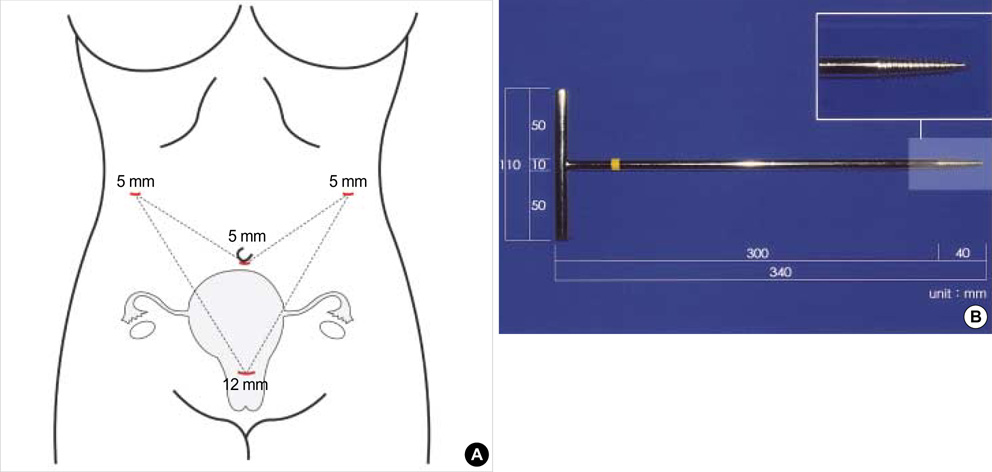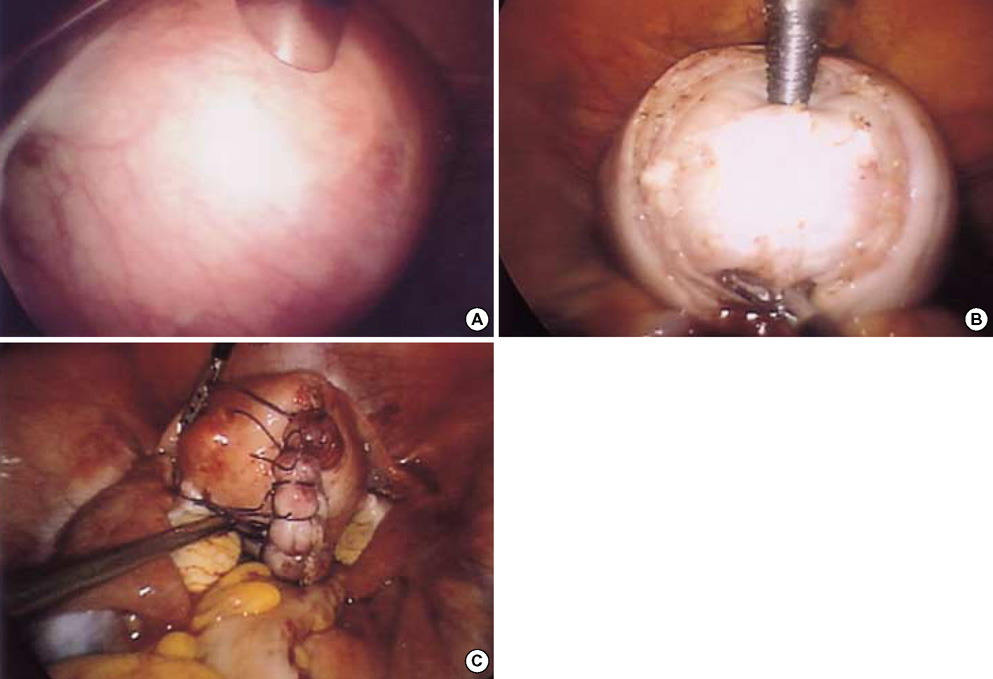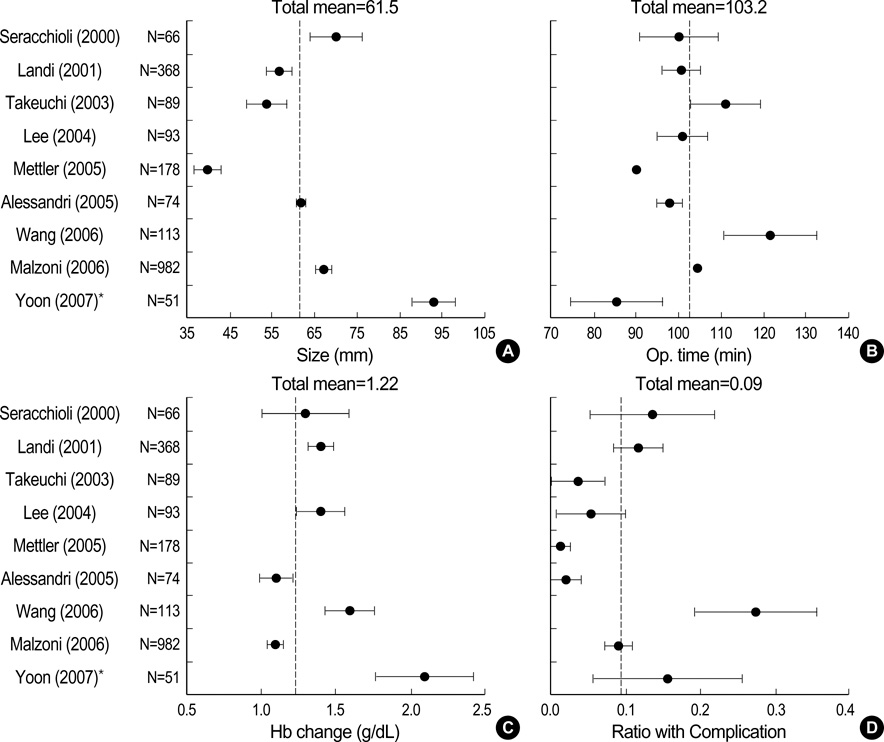J Korean Med Sci.
2007 Aug;22(4):706-712. 10.3346/jkms.2007.22.4.706.
Laparoscopic Myomectomy for Large Myomas
- Affiliations
-
- 1Department of Obstetrics and Gynecology, Kangbuk Samsung Hospital, Sungkyunkwan University School of Medicine, Seoul, Korea. yjjy.choi@samsung.com
- KMID: 1127091
- DOI: http://doi.org/10.3346/jkms.2007.22.4.706
Abstract
- The aim of this study was to assess the feasibility and efficacy of laparoscopic myomectomy (LM) for large myomas. A subpopulation of 51 patients with myomas 8 cm or larger in diameter was selected from 155 patients who underwent LM at Kangbuk Samsung Hospital from July 2003 to November 2006. The mean age of the patients was 34.9+/-5.6 yr, mean parity was 0.6+/-0.9, and 8 patients had a previous operative history. The most common operative indication was a palpable abdominal mass (24 patients, 47%). The mean operating time was 85.6+/-38.9 min, and the mean diameter of the largest myoma was 9.3+/-1.8 cm. The mean change in hemoglobin concentration was 2.1+/-1.2 g/dL. Histopathological diagnosis included 49 patients of leiomyoma (96.1%) and 2 patients of leiomyoma with adenomyosis (3.9%). Postoperatively, a transfusion was done in 7 patients, and a case of subcutaneous emphysema was noted. None of the operations was switched to laparotomy. With the newly-developed screw and the port placement system that was modified from the Choi's 4-trocar method to obtain better surgical vision, LM of large myomas proved to be one of the efficient and feasible methods.
Keyword
MeSH Terms
Figure
Reference
-
1. Hurst BS, Matthews ML, Marshburn PB. Laparoscopic myomectomy for symptomatic uterine myomas. Fertil Steril. 2005. 83:1–23.
Article2. Alessandri F, Lijoi D, Mistrangelo E, Ferrero S, Ragni N. Randomized study of laparoscopic versus minilaparotomic myomectomy for uterine myomas. J Minim Invasive Gynecol. 2006. 13:92–97.
Article3. Sinha R, Hegde A, Warty N, Patil N. Laparoscopic excision of very large myomas. J Am Assoc Gynecol Laparosc. 2003. 10:461–468.
Article4. Marret H, Chevillot M, Giraudeau B. Factors influencing laparoconversions during the learning curve of laparoscopic myomectomy. Acta Obstet Gynecol Scand. 2006. 85:324–329.
Article5. Marret H, Chevillot M, Giraudeau B. A retrospective multicentre study comparing myomectomy by laparoscopy and laparotomy in current surgical practice. What are the best patient selection criteria? Eur J Obstet Gynecol Reprod Biol. 2004. 117:82–86.6. Damiani A, Melgrati L, Marziali M, Sesti F, Piccione E. Laparoscopic myomectomy for very large myomas using an isobaric (gasless) technique. JSLS. 2005. 9:434–438.7. Glasser MH. Minilaparotomy myomectomy: a minimally invasive alternative for the large fibroid uterus. J Minim Invasive Gynecol. 2005. 12:275–283.
Article8. Fanfani F, Fagotti A, Bifulco G, Ercoli A, Malzoni M, Scambia G. A prospective study of laparoscopy versus minilaparotomy in the treatment of uterine myomas. J Minim Invasive Gynecol. 2005. 12:470–474.
Article9. Choi JS, Kyung YS, Kim KH, Lee KW, Han JS. The four-trocar method for performing laparoscopically-assisted vaginal hysterectomy on large uteri. J Minim Invasive Gynecol. 2006. 13:276–280.
Article10. Wang CJ, Yuen LT, Lee CL, Kay N, Soong YK. Laparoscopic myomectomy for large uterine fibroids: a comparative study. Surg Endosc. 2006. 20:1427–1430.11. Lee YS. Benefits of high epigastric port placement for removing the very large uterus. J Am Assoc Gynecol Laparosc. 2001. 8:425–428.
Article12. Takeuchi H, Kuwatsuru R. The indications, surgical techniques, and limitations of laparoscopic myomectomy. JSLS. 2003. 7:89–95.13. Sinha R, Hegde A, Warty N, Mahajan C. Laparoscopic myomectomy: enucleation of the myoma by morcellation while it is attached to the uterus. J Minim Invasive Gynecol. 2005. 12:284–289.
Article14. Ostrzenski A. A new laparoscopic myomectomy technique for intramural fibroids penetrating the uterine cavity. Eur J Obstet Gynecol Reprod Biol. 1997. 74:189–193.
Article15. Seracchioli R, Rossi S, Govoni F, Rossi E, Venturoli S, Bulletti C, Flamigni C. Fertility and obstetric outcome after laparoscopic myomectomy of large myomata: a randomized comparison with abdominal myomectomy. Hum Reprod. 2000. 15:2663–2668.
Article16. Kim HC, Oh ST. Safety and usefulness of laparoscopic myomectomy for intramural myoma in reproductive women. Korean J Obstet Gynecol. 2000. 43:659–664.17. Semm K, Mettler L. Technical progress in pelvic surgery via operative laparoscopy. Am J Obstet Gynecol. 1980. 138:121–127.
Article18. Landi S, Zaccoletti R, Ferrari L, Minelli L. Laparoscopic myomectomy: technique, complications, and ultrasound scan evaluations. J Am Assoc Gynecol Laparosc. 2001. 8:231–240.
Article19. Lee SY, Ryu HH, Lee CB, Joo EH, Kim SK. Clinical review on 93 cases of laparoscopic myomectomy. Korean J Obstet Gynecol. 2004. 47:1107–1112.20. Mettler L, Schollmeyer T, Shelat NR, Jonat W. Update on laparoscopic myomectomy. J Gynecol Surg. 2005. 2:173–177.
Article21. Malzoni M, Sizzi O, Rossetti A, Imperato F. Laparoscopic myomectomy: a report of 982 procedures. Surg Technol Int. 2006. 15:123–129.
- Full Text Links
- Actions
-
Cited
- CITED
-
- Close
- Share
- Similar articles
-
- Is robot-assisted laparoscopic myomectomy limited in multiple myomas?: a feasibility for ten or more myomas
- Robot-Assisted Laparoscopic Myomectomy versus Abdominal Myomectomy for Large Myomas Sized over 10 cm or Weighing 250 g
- Endoscopic management of uterine myoma
- The safety of cesarean myomectomy in women with large myomas
- Surgical outcomes for robot-assisted laparoscopic myomectomy compared with laparoscopic myomectomy




